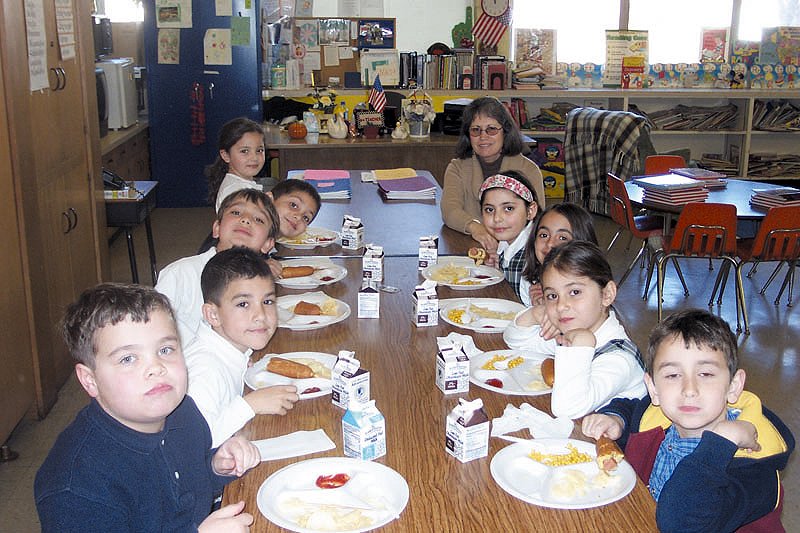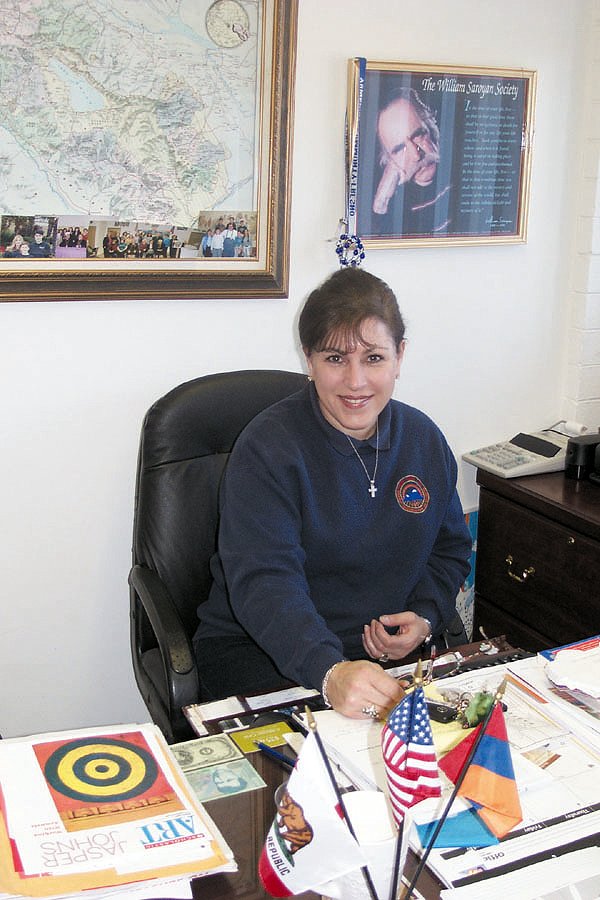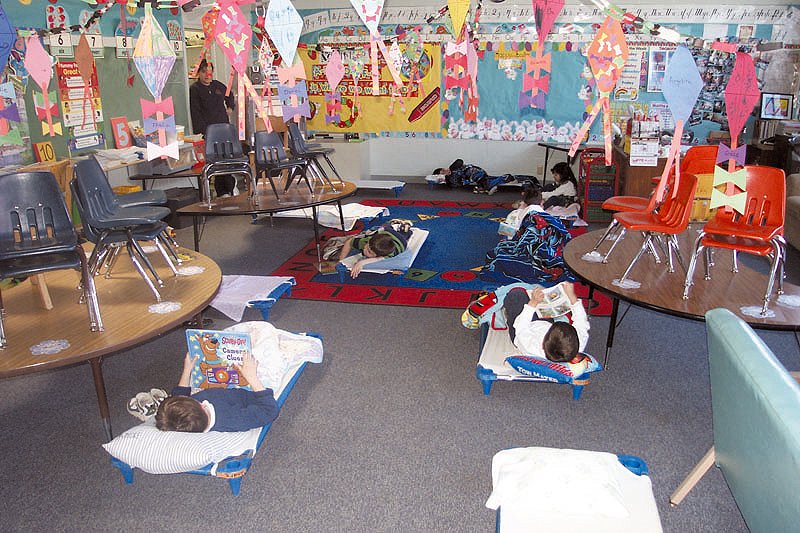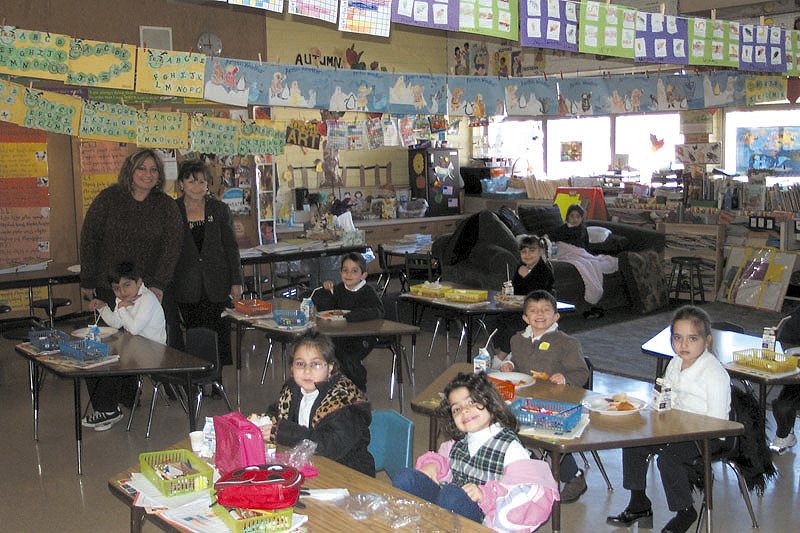Randy Baloian
Special to Hye Sharzhoom

Photo: Barlow Der Mugrdechian
It’s 9:00 am at the Armenian Community School of Fresno.
In Miss Primavera’s second grade class Hakop Mardirossian, Joseph Colarian, Alena Kutumian, and Lauren Cooper sit poised along with the other 5 or 6 students, listening intently as the teacher quizzes them on the essentials of mathematics. From an adult’s perspective, each represents a different historical element of the school. Children of recent immigrants from the Republic of Armenia. The kids of families originally from Lebanon, Aleppo, and other diasporan communities of the Middle East. Dark-eyed third generation Armenian-Americans. Freckle-faced Americans.
For the students, of course, that kind of history must wait for another time and perhaps another place. Their focus is on the lesson at hand, mixed in with thoughts about the 10:00 am recess and what sorts of games lay ahead.

Photo: Barlow Der Mugrdechian
On this day, as it has been on any school day for the past 30 years, the standard lessons are based on the same curriculum used by Fresno public schools and approved by the California State Department of Education. Each year, grades 1 through 6 collectively rank in the upper 20th percentile on the Stanford Nine Achievement Test, which measures aptitude in reading, language arts, mathematics, science, and social science. The individual scores of several students are among the highest in the state.
But what sets the ACSF apart from all other schools outside the Los Angeles and Bay areas is its emphasis on Armenian heritage-a feature that pervades the school in both obvious and subtle ways. To start the school week, all students, nursery age to 6th grade, gather during the Monday morning assembly to recite the American Pledge of Allegiance and sing the Armenian national anthem, Mer Hairenik (Our Fatherland).
Birthdays are duly recognized, and the student-of-the-day gets to choose whether his classmates mark the occasion with the familiar “Happy Birthday” or by its Armenian version, Paree Daretartz. Even outside Armenian class, compliments for good behavior or performance are sometimes accentuated with “Abris! ” (well done), and teachers occasionally deliver disciplinary warnings in Armenian-just to add a little more emphasis.
Of course, Armenian language instruction is what attracts most families to the school. Reflecting on her own experience as a child growing up in a Sacramento suburb with few Armenians, parent Deanna Garabedian says,
“It is very special and heart warming for me, as a first and second generation Armenian, to see my child along with everyone else speaking, reading, writing, and singing the language of their ancestors.”
Beginning at the Pre-Kindergarten level, children are introduced to the Armenian alphabet, and by the first grade, even students with no previous knowledge of the language are able to speak, read, write, and understand Armenian.
Armenian education does not end with language. Armenian history is taught to the upper grades, and throughout the year, the entire school recognizes such important historical dates as January 6th (Armenian Christmas), May 28th (Independence of the 1st Armenian Republic), September 21 (Independence of the current Republic of Armenia), and April 24th (Commemoration of the Armenian Genocide).
This February, the ACSF observed Saint Vartan’s day by participating in a community-wide event at the First Presbyterian Armenian Church. The commemoration of Saint Vartan, or Vartanantz, marks the famous 451 AD battle between the Armenian and Persian armies, in which General Vartan Mamigonian and his fellow soldiers perished defending Armenia’s right to practice Christianity. Although the clash left the Armenian forces decimated, it sparked a 30 year-long popular struggle that eventually succeeded in securing religious freedom for Armenia.
At a time when secularism and religion are having their own battle in the classroom, the ACSF has achieved a comfortable balance where Christian belief is neither stressed nor discouraged but simply accepted. On selected Friday assemblies, clergy from the four Fresno Armenian churches visit the students to give a brief parable and spiritual lesson. Indeed, it would be next to impossible to convey Armenian history since 301 A.D., the year Armenia became the first Christian nation, without some understanding and appreciation of the faith. During her lecture to students earlier in the year about Mesrop Mashtots, the creator of the Armenian alphabet, Armenian instructor Maral Markarian elegantly tied together religion, language, and history. Recalling the words of the poet Avetik Isahakian, Markarian said,
“When you want to talk to God, speak in Armenian. Our language is a prayer language, a spiritual language.”
* * *
The mid-1970s, though probably not apparent at the time, was a watershed period in the history of the Fresno Armenian Community. Compared to previous decades, there was a greater sense of identity, due in part to the growing number of newly arrived Armenians fleeing the instability of the Middle East. It was in this context that the Armenian Community School of Fresno was established.
In 1976, largely through the efforts of Rev. Fr. Kourken Yaralian and a group of motivated businessmen, professionals, and clergy who became the “founding fathers” of the school, the Armenian Community School of Fresno was created. Meher Chekerdemian, one of the members of that committee, recalls some of the problems involved in getting the school established.

Photo: Barlow Der Mugrdechian
“We had essentially three obstacles to overcome: finding the financial support; finding a location; and finding the students. Ironically, these are the same challenges facing the school today. I remember our first fund raiser collected about $60-$70,000, enough to get the school off the ground. Because we were a community school and did not want it to be associated with only one church, we approached the local churches for a location and were eventually accepted by Holy Trinity Armenian Apostolic Church. As far as finding students, Father Yaralian literally went from home to home to convince families about the benefits of sending their children to the school.”
The first year, classes, with a total of 22 students, were held in the basement of Holy Trinity and Hagop Terjimanian served as the school’s first principal. Terjimanian was succeeded by Lu Ann Missakian, Deran Berberian, Diane Emerzian, Assadour Assadourian, Seth Atamian, and the current principal Rosie Bedrosian-all of whom have continued the school’s tradition of academic achievement.
Four years after its inception and feeling the growing pains of rising enrollment, the school moved to its long-time home on Fresno Street and Weldon Avenue. For the next two decades, the two-story building routinely accommodated 100 or more students.
Unfortunately, by late 1990s, the urban decay of the surrounding neighborhood coupled with the nearby construction of the Highway 41/Highway 168 interchange compelled the school’s educational board to relocate the ACSF to another site. In 2001, the school moved to its present campus at the Saint Therese Catholic Church in Fresno’s Tower District. The former parochial school, which is rented to the ACSF, was intended as a temporary facility, since the ACSF had received a land donation from a local developer. However, these plans never materialized due to the prohibitive costs involved with this project.
This past December, the school received some bad news when it was informed that Saint Therese would be making major improvements to the grounds and that it would be unable to renew the lease for another term. The ACSF current educational board, which had previously considered alternative locations, has stepped-up its efforts to find a new site before the Fall. The ACSF has been reaching out to the community to aid in this search.
The ACSF is truly a community school in that it does not rely on the financial backing of one benefactor or one organization but on the grass-roots support of its many donors. In this sense, it is an anomaly compared to other California Armenian schools, all of which are named after a major patron and fall under the umbrella of a larger entity such as the Armenian Prelacy or Armenian General Benevolent Union.
The concept of an independent school does have some appeal to a diasporan community like Fresno, which consists of several-and at times contentious-religious, political, and social elements. Moreover, if it weren’t for the generous support of its diverse base of contributors, the ACSF would have closed long ago. The ACSF Women’s League and Parent Teacher Club play an important role in increasing the school’s visibility through their many fund raisers.
Yet it would be an overstatement to say the community has embraced the ACSF, and it is remarkable that the school has endured for 30 years as an autonomous entity. In many respects, the ACSF has an orphan-like status in the broader community. An ACSF board member explained it this way:
“The response of the community to our fund-raising events is impressive. For the past two years, our annual crab feed had over 450 people attending. Each year we receive tens of thousands of dollars in donations necessary for the school’s continued existence.”
“On the other hand, I feel there is sometimes this unspoken perception among the community that the school is a burden or that it is somehow not up to par. In other words, while people willingly donate materially to the school, individuals and organizations are hesitant to invest in the school in ways that would be mutually beneficial. For thirty years, the school has a proven itself year in and year out by providing a quality education to its students. Unfortunately only a small fraction of the community’s youth attends the ACSF because for whatever reasons, most parents would rather send their children to over-crowded public schools.”
One example of how such cooperative endeavors can positively impact the school has been the new orchestral music program. Earlier in the year, Patrick Balakian of Balakian’s Music approached the ACSF with the idea to integrate instrumental music into the school’s standard curriculum. ** Like Armenian language and history, the orchestral music program is something the public schools do not offer, and Balakian made his proposal flexible and affordable enough to fit into the school’s tight budget. The classes, which begin at the 1st grade level and continue upward, are currently being taught by Ms. Selin Eskandarian, who is coincidentally an alumnus of the ACSF. ** She describes her return to the ACSF as “very rewarding,” adding that the excitement from the children is very apparent when they get to handle musical instruments for the first time. Along with the basic musical instruction, the students are learning traditional Armenian pieces that will be performed at the year-end Hantes in June.
Lately, the search for a new site has occupied the minds of everyone associated with the ACSF, yet from the very beginning the school has never been about its location or the facilities but about what goes on inside in the buildings. For the past 30 years, the collective backbone of the school has been the remarkable dedication of its teachers and staff as well as the commitment of its families to provide their children with not just a primary education, but an education imbued with an understanding of Armenian history and language.
Many students enter the ACSF at the Nursery or Pre-Kindergarten level and continue right on up to the 6th grade. The challenges of teaching pre-school come not only from the children but also from new parents, many of whom are leaving their sons and daughters in someone else’s care for probably the first time. To reassure parents, Nursery school teacher Annette Agulian adopts a flexible approach in dealing with this separation anxiety.
“We take it slow the first couple of months. In most cases, it’s best if the child can immediately begin to adjust to the new surroundings without the parents, but I also explain that the parents are welcome to stay in the class as long as they want. Once the children become familiar to their caretakers and classmates, they sometimes don’t want to go home at the end of the day.”
While the ACSF pre-school program is an affordable alternative to other child care institutions in the Fresno area, the curriculum of the school’s Pre-K class goes well beyond the content and breath of the standard day care facility. Students practice social skills and learn introductory concepts in math and English. It is also here that Armenian instruction begins. Pre-School Director Vicky Kataroyan, who has been with the school since 1982, comments that the combination of love and discipline has a powerful effect in the development of the students. “I cannot accept it when children say ‘I can’t do this’ and instead assure them that they are capable of doing anything they put their minds to.”
After graduating from Pre-K, the students are well-prepared to move on to primary school. Anyone who watches Kindergarten teacher Jackie Chekerdemian interact with her current and former pupils can’t help but look at her as the students’ older sister. When asked about that special relationship, Chekerdemian says,
“They are more than just students to me. They are my children. The friendships they make here will last throughout their whole lives. You can’t get that type of family environment from a public school.”

Photo: Barlow Der Mugrdechian
First grade instructor Maida Derkalousdian has taught at the school since 1981 and has deeply rooted ties with the ACSF. She has a granddaughter in Nursery, and her daughter-in law, Zepur Derkalousdian, is the Armenian instructor for the upper grades. Derkalousdian, who also has the ability to seamlessly forge both warmth and discipline in her teaching style, arrives at school each day with the same affection and focus that she instills in her students. “I feel like this is my second home. When I come here, I see only the students.”
Throughout the week the students are kept busy with various activities. Long before instrumental music was begun at the school, choir music has been a staple of the school curriculum. That weekly class is currently taught by Ms. Shoghig Papoyan, who also arranges the musical scores for the yearly Hantes and other community performances. Kataroyan considered such events-in which students of each class recite poems, sing songs, or dance before hundreds of onlookers-as invaluable to the school, not only by showcasing its talents but, more importantly, from the standpoint of building the self-esteem of each student. Last year, second grade teacher Melissa Primavera coordinated and choreographed the year end Hantes, a production that featured various fairy-tales made popular by Disney.
As the students progress into the upper grades, the educational opportunities expand with their growing independence. Third and fourth grade teacher Talin Tanossian is currently having her students construct a model of the solar system from a shoe box and other basic materials-a project that combines art and crafts with astronomy. Last year, they were encouraged to paint their version of Vincent Van Gogh’s famous image, “The Starry Night.” Tanossian notes that given the countless number of possibilities, she rarely repeats such assignments from year to year. Other extra-curricular activities include the school’s many field trips. During the Winter Semester, for instance, grades 3 through 5 walked a few blocks down to the historic Tower Theatre, where they attended a performance of “The Most Valuable Player,” a play that celebrates the life of Jackie Robinson and his impact on baseball and American society.
By the time a student has reached the sixth grade, he or she has spent at least 7 years with the same cohort of classmates. Sixth grade teacher MacDonald, who has been with the school for 10 years, remarks that: “They’re like brothers and sisters. They know each other’s idiosyncrasies. Occasionally, they even quarrel like siblings. But they are so close.”
A former substitute teacher in the public school system, MacDonald likes the flexibility afforded to her at the ACSF, adding that “I can devote more of time to teaching and less to the red tape that is typical of public schools.” In fact, the fifth and sixth grade class is in continual motion. To name just a few of its outings, the class has visited the Challenger Learning Center in Atwater, the UC Berkeley campus for a science program, and the Monterey Bay Aquarium with the third and fourth graders. She is also planning a 4-day camping excursion to Morro Bay and a one-day tour of the State Capitol later in the year. Perhaps the most memorable journey for the students is a one week trip to Armenia, a journey the fifth and sixth graders take on alternate years. Principal Rosie Bedrosian remembers when the school first made the trek to Armenia:
“On the occasion of the 1700th anniversary of Christianity in 2001, our upper grade students traveled to Armenia. The group included parents, teachers, and former graduates of the ACSF. This was a once in a lifetime opportunity for our students to visit their homeland and see the living legacy of their forefathers. Being able to attend Sunday services at Holy Etchmiadzin in the audience of His Holiness Karekin II, Catholicos of all Armenians on Palm Sunday, was an experience that our students can never forget. The trip was such a success that it has become a bi-annual event for our upper grade class.”
MacDonald, who also has a granddaughter in the ACSF pre-school, enjoys the amount of support she gets from the parents, a sentiment echoed by all the teachers.
Parental participation is essential for the school. The Parent Teacher Club holds a variety of fund raising events throughout the year to offset the school’s expense. Among the PTC most active members are the fathers and mothers of the school’s small but energetic non-Armenian contingent. Most notably, Rose Willems Camerena has leant her leadership and public relation skills ever since joining the ACSF. Also included are neighborhood families and parents who, having looked into the ACSF as an educational institution, simply appreciate the quality of instruction and family atmosphere the school provides. Referring to her non-Armenian students, Tanossian reflects that “perhaps they leave the school with an awareness of not just Armenian culture but of all cultures.”
At recess the kids are running about, skipping rope, shooting baskets-doing what kids normally do. In a corner of the playground, one of the citizens of the second grade has taken hold of a small nerf football. Chased and finally surrounded by her classmates, she now forms the center of one big, laughing group hug. The smell of the day’s lunch-sometimes chicken and pilav, sometimes mac and cheese, sometimes lahmajoon-is wafting out from cook Zarouhi Karadanyan’s kitchen. On this day, at least, all seems right for the Armenian Community School of Fresno.
For more information on the Armenian Community School of Fresno, please phone the school office at 559-233-1800.
 Hye Sharzhoom Armenian Action
Hye Sharzhoom Armenian Action